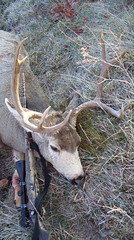Post by Purebred Redneck on Nov 30, 2006 15:49:38 GMT -5
This is taken from Chuck Hawks's site and can be accessed through www.chuckhawks.com/limber_ramrod_2006.htm
Across the U.S., muzzleloader-hunting regulations have become more relaxed, more modern in recent years as shooter interest has grown from a nostalgic pursuit into a bona fide hunting sport. And to meet the demands of big game hunters desiring improved performance, muzzleloading rifle manufacturers, bullet makers and powder producers have responded with an unbelievable selection of new products that easily eclipse the performance of rifles and loads dating from the past. Unfortunately, not all game departments have embraced the dramatic step up in muzzleloader accuracy, velocity and range. Consequently, a few have fought the desires of the more than 3-million muzzleloading hunters in this country, and in an attempt to restrict the maximum effective range of the muzzleloading hunter, some agencies have imposed tight restrictions on what the hunter can or cannot use.
For the past two decades, muzzleloading has experienced what can only be referred to as accelerated metamorphosis. The rifles and the performance they were capable of delivering literally changed right before the muzzleloading hunter's eyes. Most state game departments realized the benefits of cleaner one-shot harvests of big game due to easier shot placement and higher levels of bullet energy. The efficiency of the new guns and loads also attracted a whole new segment of hunters looking to take advantage of the special "Muzzleloader Only" seasons being established coast-to-coast. The rapid growth of muzzleloader hunting was a win-win for both hunters and game departments. While the hunter enjoyed more time in the field, game departments had one more management tool that could effectively help keep burgeoning game populations under control. Still, there are a few game agencies that continue to fight the changes in muzzleloading, even though the sport will never entirely return to its old ways.
The Oregon Department of Fish and Wildlife presently enforces the most outdated muzzleloader hunting regulations in the nation. Muzzleloading hunters in this state cannot use a scope during the muzzleloader seasons or hunts. Regulations in this state also prohibit fiber-optic sights, primer ignition, pelletized powders, saboted bullets, or even bore-sized conical bullets that are more than twice their diameter in length, or which incorporate a plastic gas check. Only rifles with an ignition system that's exposed to the weather are permitted. Enclosed ignition rifles are not allowed. In short, the Oregon muzzleloader hunting regulations make it illegal for the muzzleloading hunter to use the vast majority of the guns, loads and accessories that have made muzzleloading so popular with hunters nationwide. And for that reason, the High Performance Muzzleloading web magazine has chosen the Oregon Department of Fish and Wildlife as the first annual recipient of the "Limber Ramrod Award" for the Nation's absolute worst muzzleloader hunting regulations.
The Colorado Division of Wildlife came in a close second. Also in the running for the 2006 award were the Washington Department of Fish and Wildlife and the Idaho Game & Fish. While the regulations in these states are not quite as restrictive as those in Oregon, they nonetheless prevent the muzzleloading hunter from heading out with the most efficient rifle, load and sighting system available for the task at hand, and that's cleanly and humanely taking the big game they are hunting. High Performance Muzzleloading feels this is a violation of sound game management and goes against promoting good hunter ethics.
I personally applaud Oregon for not bending the rules and would love to hunt there someday
Across the U.S., muzzleloader-hunting regulations have become more relaxed, more modern in recent years as shooter interest has grown from a nostalgic pursuit into a bona fide hunting sport. And to meet the demands of big game hunters desiring improved performance, muzzleloading rifle manufacturers, bullet makers and powder producers have responded with an unbelievable selection of new products that easily eclipse the performance of rifles and loads dating from the past. Unfortunately, not all game departments have embraced the dramatic step up in muzzleloader accuracy, velocity and range. Consequently, a few have fought the desires of the more than 3-million muzzleloading hunters in this country, and in an attempt to restrict the maximum effective range of the muzzleloading hunter, some agencies have imposed tight restrictions on what the hunter can or cannot use.
For the past two decades, muzzleloading has experienced what can only be referred to as accelerated metamorphosis. The rifles and the performance they were capable of delivering literally changed right before the muzzleloading hunter's eyes. Most state game departments realized the benefits of cleaner one-shot harvests of big game due to easier shot placement and higher levels of bullet energy. The efficiency of the new guns and loads also attracted a whole new segment of hunters looking to take advantage of the special "Muzzleloader Only" seasons being established coast-to-coast. The rapid growth of muzzleloader hunting was a win-win for both hunters and game departments. While the hunter enjoyed more time in the field, game departments had one more management tool that could effectively help keep burgeoning game populations under control. Still, there are a few game agencies that continue to fight the changes in muzzleloading, even though the sport will never entirely return to its old ways.
The Oregon Department of Fish and Wildlife presently enforces the most outdated muzzleloader hunting regulations in the nation. Muzzleloading hunters in this state cannot use a scope during the muzzleloader seasons or hunts. Regulations in this state also prohibit fiber-optic sights, primer ignition, pelletized powders, saboted bullets, or even bore-sized conical bullets that are more than twice their diameter in length, or which incorporate a plastic gas check. Only rifles with an ignition system that's exposed to the weather are permitted. Enclosed ignition rifles are not allowed. In short, the Oregon muzzleloader hunting regulations make it illegal for the muzzleloading hunter to use the vast majority of the guns, loads and accessories that have made muzzleloading so popular with hunters nationwide. And for that reason, the High Performance Muzzleloading web magazine has chosen the Oregon Department of Fish and Wildlife as the first annual recipient of the "Limber Ramrod Award" for the Nation's absolute worst muzzleloader hunting regulations.
The Colorado Division of Wildlife came in a close second. Also in the running for the 2006 award were the Washington Department of Fish and Wildlife and the Idaho Game & Fish. While the regulations in these states are not quite as restrictive as those in Oregon, they nonetheless prevent the muzzleloading hunter from heading out with the most efficient rifle, load and sighting system available for the task at hand, and that's cleanly and humanely taking the big game they are hunting. High Performance Muzzleloading feels this is a violation of sound game management and goes against promoting good hunter ethics.
I personally applaud Oregon for not bending the rules and would love to hunt there someday










